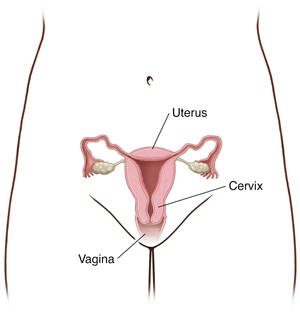Understanding Cervical Biopsy
The cervix is the narrowest part of your uterus. It links the uterus to the vagina.
A cervical biopsy removes a tiny piece of tissue from your cervix. This tissue is sent to a lab. It's checked for any problems in the cells, such as precancerous changes or cancer.

Why cervical biopsy is done
This procedure may be done if you have a positive HPV test, an abnormal Pap test, or a change is found during a pelvic exam. A biopsy helps find cancer or cell changes that could become cancer over time.
How cervical biopsy is done
A cervical biopsy is often done on an outpatient basis. This means you can go home afterward. In general, here is what you can expect during the procedure:
-
Your healthcare provider puts a speculum into your vagina. It holds your vagina open so your entire cervix can be seen.
-
A colposcope might be used to look at your cervix. This tool magnifies the surface of your cervix so the provider can see even small areas of changed cells. It doesn't touch your body.
-
The provider may wipe a solution that's a lot like dilute vinegar on your cervix if colposcopy is to be done. This solution makes any changed cells turn white. It can show changes that help the provider find any areas of concern.
-
The provider may use a small needle to inject numbing medicine into your cervix. This is so you don’t feel pain. But it's often not needed.
-
There are many ways to remove cells or tissue from the cervix:
-
-
A scissor-like tool called a biopsy punch can be put on the abnormal area of your cervix. Your provider closes the punch to remove a tiny piece of tissue.
-
A small, spoon-shaped tool called a curette can be used to scrape out cells.
-
Another option is a loop electrosurgical excision procedure (LEEP). The provider uses a small, thin, heated wire loop to remove a piece of tissue. This is often used for treatment, not for a simple biopsy.
-
A brown paste might be put on the area to stop any bleeding. You may need a stitch if the bleeding doesn’t stop.
-
The tissue is sent to a lab to be tested for cancer or other cell changes.
Another type of cervical biopsy is called conization or a cone biopsy. This is done much the same way as the others. But sometimes medicines are used so you sleep and don't feel pain (general anesthesia). In this case, the biopsy is done in the hospital. A cone biopsy removes a bigger, cone-shaped piece of tissue from the cervix. It can sometimes also be used as treatment because it allows the provider to take out all the changed cells.
Risks of cervical biopsy
These include:
-
Bleeding
-
Cramps
-
Infection
Your healthcare team will talk with you about which biopsy is best for you and what you can expect it to be like. Talk with your provider about any questions you have. Also ask when and how you will get the results of your biopsy.